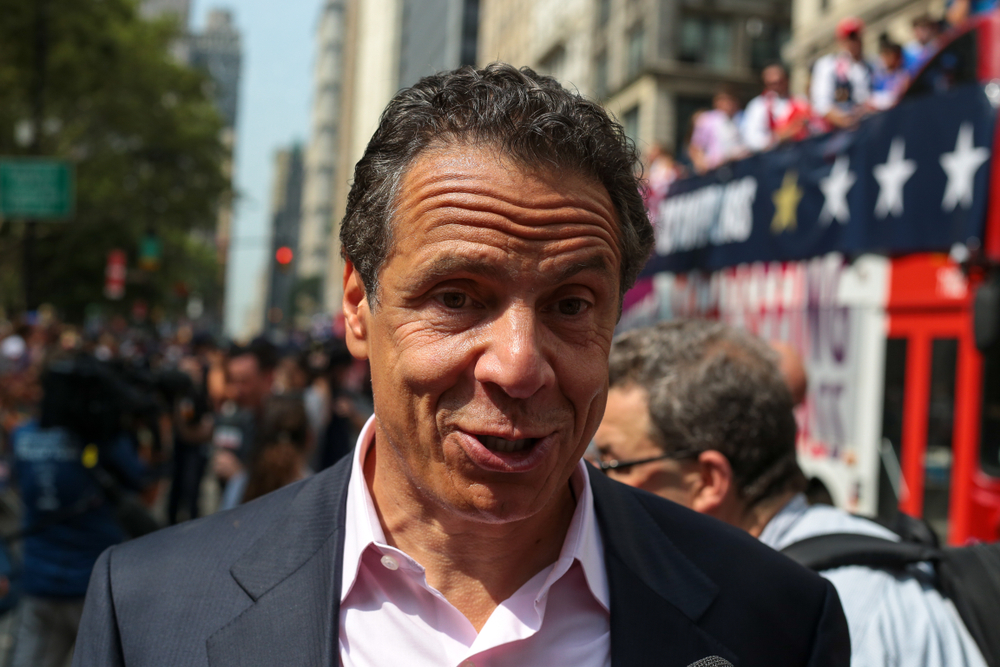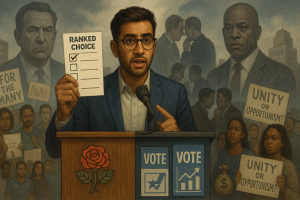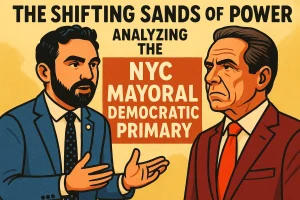By Brian Figeroux, Esq. | Editorial credit: Steve Edreff / shutterstock.com
As the 2025 New York City mayoral race intensifies ahead of the June 24 Democratic primary, five candidates have emerged as frontrunners, each presenting distinct visions for the city’s future. This analysis delves into their standings, campaign strategies, and the factors influencing their positions in the polls.
Andrew Cuomo: The Comeback Contender
Former Governor Andrew Cuomo leads the Democratic primary with approximately 38–41% support, according to recent polls. Despite resigning in 2021 amid sexual harassment allegations, Cuomo’s extensive political experience and name recognition have bolstered his campaign.
Strengths:
- Established Political Profile: Cuomo’s tenure as governor provides him with a wealth of experience and a recognizable name, aiding his campaign’s visibility.
- Labor Union Support: He has secured endorsements from influential labor unions, including 1199SEIU, enhancing his appeal among working-class voters.
Challenges:
- Progressive Skepticism: Cuomo faces criticism from progressive groups, particularly LGBTQ organizations, which have endorsed other candidates, citing concerns about his past controversies and commitment to progressive causes.
- Ranked-Choice Voting Dynamics: While leading in first-choice votes, Cuomo’s limited appeal as a second or third choice in the ranked-choice voting system could pose a risk if other candidates consolidate broader support.
Zohran Mamdani: The Progressive Challenger
Assemblymember Zohran Mamdani, a Democratic Socialist representing Queens, has gained significant traction, polling at 15%. His campaign emphasizes progressive policies aimed at addressing economic inequality.
Strengths:
- Grassroots Support: Mamdani’s campaign has garnered substantial grassroots backing, including endorsements from prominent progressive figures and organizations.
- Policy Proposals: He advocates for universal childcare, free public transportation, and affordable housing initiatives, resonating with voters seeking systemic change.
Challenges:
- Controversies: Mamdani faced allegations of using AI to simulate Spanish fluency in a campaign ad, which he denied, but the incident may have impacted his credibility among some voters.
- Electability Concerns: Some critics argue that his policies may be too radical for the broader electorate, potentially limiting his appeal in a general election.
Brad Lander: The Fiscal Progressive
New York City Comptroller Brad Lander is polling at around 6–8% . Known for his focus on fiscal responsibility and progressive values, Lander aims to position himself as a pragmatic alternative.
Strengths:
- Financial Oversight Experience: As Comptroller, Lander has experience managing the city’s finances, which he leverages to advocate for responsible budgeting aligned with progressive goals.
- Endorsements: He has received endorsements from various progressive organizations and labor unions, bolstering his campaign’s credibility.
Challenges:
- Name Recognition: Despite his qualifications, Lander struggles with lower name recognition compared to frontrunners like Cuomo and Mamdani.
- Fundraising: While he has qualified for public matching funds, his overall fundraising totals lag behind some competitors, potentially limiting his campaign’s reach.
Adrienne Adams: The Institutional Leader
City Council Speaker Adrienne Adams is polling at approximately 4–5% . Her campaign emphasizes experience in city governance and a commitment to public service.
Strengths:
- Endorsements: Adams has secured endorsements from influential figures, including State Attorney General Letitia James and major municipal unions like DC 37, enhancing her appeal among institutional supporters.
- Legislative Experience: Her tenure as City Council Speaker provides her with a deep understanding of city operations and legislative processes.
Challenges:
- Late Entry: Adams entered the race later than some competitors, which may have impacted her ability to build early momentum.
- Fundraising: She has faced challenges in fundraising, not qualifying for public matching funds, which could limit her campaign’s outreach efforts.
Zellnor Myrie: The Community Advocate
State Senator Zellnor Myrie is polling at around 4–6%. His campaign focuses on community engagement and addressing local issues, particularly in Central Brooklyn.
Strengths:
- Community Roots: Myrie’s background and legislative work resonate with constituents seeking representation that understands their daily challenges.
- Policy Initiatives: He advocates for expanding affordable housing and after-school programs, aiming to address systemic inequalities.
Challenges:
- Limited Visibility: Despite his community engagement, Myrie faces challenges in gaining broader citywide recognition.
- Campaign Resources: His campaign’s financial resources are more limited compared to frontrunners, potentially impacting his ability to amplify his message.
Conclusion
The 2025 New York City mayoral race presents a diverse array of candidates, each bringing unique perspectives and policy priorities. Andrew Cuomo leads the field, leveraging his political experience, while Zohran Mamdani offers a progressive alternative appealing to younger and left-leaning voters. Brad Lander, Adrienne Adams, and Zellnor Myrie each bring distinct strengths, focusing on fiscal responsibility, institutional knowledge, and community advocacy, respectively.
As the primary approaches, the dynamics of ranked-choice voting and the candidates’ abilities to build broad coalitions will play crucial roles in determining the next mayor of New York City.




